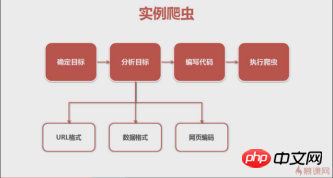
##There is still a lot of music on qq music. Sometimes I want to download good music, but There is an annoying login process every time when downloading from a web page. So, here comes a qqmusic crawler. At least I think the most important thing for a for loop crawler is to find the URL of the element to be crawled. Let’s start looking (don’t laugh at me if I’m wrong)
<br>
## 2. Python crawls QQ music singles
 ## Crawler steps
## Crawler steps
First of all, we need to clarify the goal. This time we crawled the singles of QQ Music singer Andy Lau.
(Baidu Encyclopedia)->Analysis target (strategy: url format (range), data format, web page encoding)->Write code->Execute crawler 2. Analysis targetSong link:
From the screenshot on the left, you can know that singles use paging to arrange song information. Each page displays 30 items, a total of 30 pages. Clicking on the page number or the ">" on the far right will jump to the next page. The browser will send an asynchronous ajax request to the server. From the link, you can see the begin and num parameters, which represent the starting song subscript respectively (the screenshot is the 2nd page, the starting subscript is 30) and one page returns 30 items, and the server responds by returning song information in json format (MusicJsonCallbacksinger_track({"code":0,"data":{"list":[{"Flisten_count1":. .....]})), if you just want to obtain song information alone, you can directly splice the link request and parse the returned json format data. Here we do not use the method of directly parsing the data format. I use the Python Selenium method. After each page of single information is obtained and parsed, click ">" to jump to the next page and continue parsing until all the information is parsed and recorded. Single information. Finally, request the link of each single to obtain detailed single information. 


1 ) Download web page content. Here we use Python’s Urllib standard library and encapsulate a download method:
def download(url, user_agent='wswp', num_retries=2):
if url is None:
return None
print('Downloading:', url)
headers = {'User-Agent': 'Mozilla/5.0 (Windows NT 10.0; Win64; x64) AppleWebKit/537.36 (KHTML, like Gecko) Chrome/58.0.3029.110 Safari/537.36'}
request = urllib.request.Request(url, headers=headers) # 设置用户代理wswp(Web Scraping with Python)
try:
html = urllib.request.urlopen(request).read().decode('utf-8')
except urllib.error.URLError as e:
print('Downloading Error:', e.reason)
html = None
if num_retries > 0:
if hasattr(e, 'code') and 500 <= e.code < 600:
# retry when return code is 5xx HTTP erros
return download(url, num_retries-1) # 请求失败,默认重试2次,
return html<br>
def music_scrapter(html, page_num=0):
try:
soup = BeautifulSoup(html, 'html.parser')
mod_songlist_div = soup.find_all('div', class_='mod_songlist')
songlist_ul = mod_songlist_div[1].find('ul', class_='songlist__list')
'''开始解析li歌曲信息'''
lis = songlist_ul.find_all('li')
for li in lis:
a = li.find('div', class_='songlist__album').find('a')
music_url = a['href'] # 单曲链接
urls.add_new_url(music_url) # 保存单曲链接
# print('music_url:{0} '.format(music_url))
print('total music link num:%s' % len(urls.new_urls))
next_page(page_num+1)
except TimeoutException as err:
print('解析网页出错:', err.args)
return next_page(page_num + 1)
return Nonedef get_music():
try:
while urls.has_new_url():
# print('urls count:%s' % len(urls.new_urls))
'''跳转到歌曲链接,获取歌曲详情'''
new_music_url = urls.get_new_url()
print('url leave count:%s' % str( len(urls.new_urls) - 1))
html_data_info = download(new_music_url)
# 下载网页失败,直接进入下一循环,避免程序中断
if html_data_info is None:
continue
soup_data_info = BeautifulSoup(html_data_info, 'html.parser')
if soup_data_info.find('div', class_='none_txt') is not None:
print(new_music_url, ' 对不起,由于版权原因,暂无法查看该专辑!')
continue
mod_songlist_div = soup_data_info.find('div', class_='mod_songlist')
songlist_ul = mod_songlist_div.find('ul', class_='songlist__list')
lis = songlist_ul.find_all('li')
del lis[0] # 删除第一个li
# print('len(lis):$s' % len(lis))
for li in lis:
a_songname_txt = li.find('div', class_='songlist__songname').find('span', class_='songlist__songname_txt').find('a')
if 'https' not in a_songname_txt['href']: #如果单曲链接不包含协议头,加上
song_url = 'https:' + a_songname_txt['href']
song_name = a_songname_txt['title']
singer_name = li.find('div', class_='songlist__artist').find('a').get_text()
song_time =li.find('div', class_='songlist__time').get_text()
music_info = {}
music_info['song_name'] = song_name
music_info['song_url'] = song_url
music_info['singer_name'] = singer_name
music_info['song_time'] = song_time
collect_data(music_info)
except Exception as err: # 如果解析异常,跳过
print('Downloading or parse music information error continue:', err.args)<span style="font-size: 16px;">爬虫跑起来了,一页一页地去爬取专辑的链接,并保存到集合中,最后通过get_music()方法获取单曲的名称,链接,歌手名称和时长并保存到Excel文件中。</span><br><span style="font-size: 14px;"><img src="/static/imghw/default1.png" data-src="https://img.php.cn/upload/article/000/000/001/a1138f33f00f8d95b52fbfe06e562d24-4.png" class="lazy" alt="" style="max-width:90%" style="max-width:90%"><strong><img src="/static/imghw/default1.png" data-src="https://img.php.cn/upload/article/000/000/001/9282b5f7a1dc4a90cee186c16d036272-5.png" class="lazy" alt=""></strong></span>
<br>
2.url link manager uses a collection data structure to save single links. Why use collections? Because multiple singles may come from the same album (with the same album URL), this can reduce the number of requests.
class UrlManager(object):<br> def __init__(self):<br> self.new_urls = set() # 使用集合数据结构,过滤重复元素<br> self.old_urls = set() # 使用集合数据结构,过滤重复元素
def add_new_url(self, url):<br> if url is None:<br> return<br> if url not in self.new_urls and url not in self.old_urls:<br> self.new_urls.add(url)<br><br> def add_new_urls(self, urls):<br> if urls is None or len(urls) == 0:<br> return<br> for url in urls:<br> self.add_new_url(url)<br><br> def has_new_url(self):<br> return len(self.new_urls) != 0<br><br> def get_new_url(self):<br> new_url = self.new_urls.pop()<br> self.old_urls.add(new_url)<br> return new_url<br><br>
, and the single information can be well saved through the Excel file. def write_to_excel(self, content):<br> try:<br> for row in content:<br> self.workSheet.append([row['song_name'], row['song_url'], row['singer_name'], row['song_time']])<br> self.workBook.save(self.excelName) # 保存单曲信息到Excel文件<br> except Exception as arr:<br> print('write to excel error', arr.args)<br><br>
Points that need to be optimized in the future:
1. There are many download links, and it is slow to download one by one. We plan to use multi-threaded concurrent downloading later.
2. The download speed is too fast. In order to avoid the server disabling the IP and the problem of too frequent access to the same domain name later, there is a waiting mechanism, and there is a wait between each request. interval.
3. Parsing web pages is an important process. Regular expressions, BeautifulSoup and lxml can be used. Currently, the BeautifulSoup library is used. In terms of efficiency, BeautifulSoup is not as efficient as lxml. Later, Will try to use lxml.
The above is the detailed content of Example of the process of crawling qq music with Python. For more information, please follow other related articles on the PHP Chinese website!




